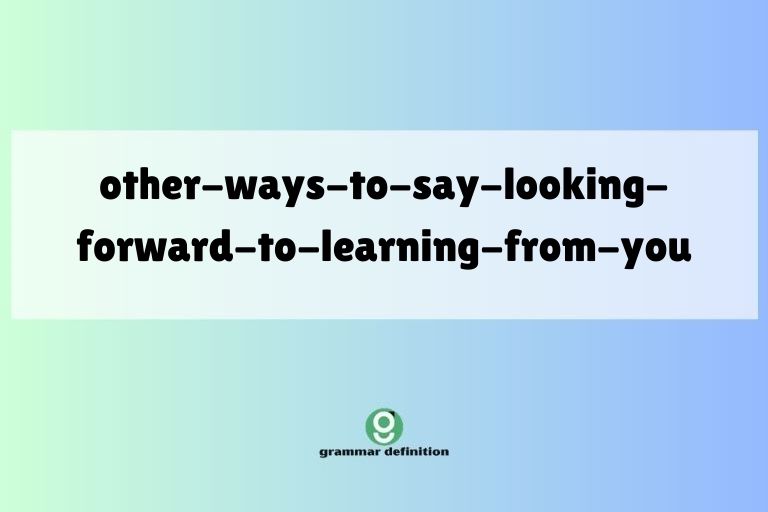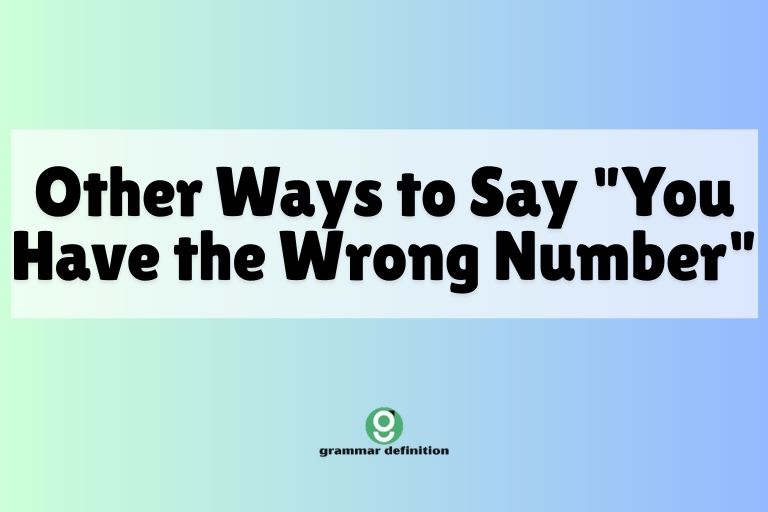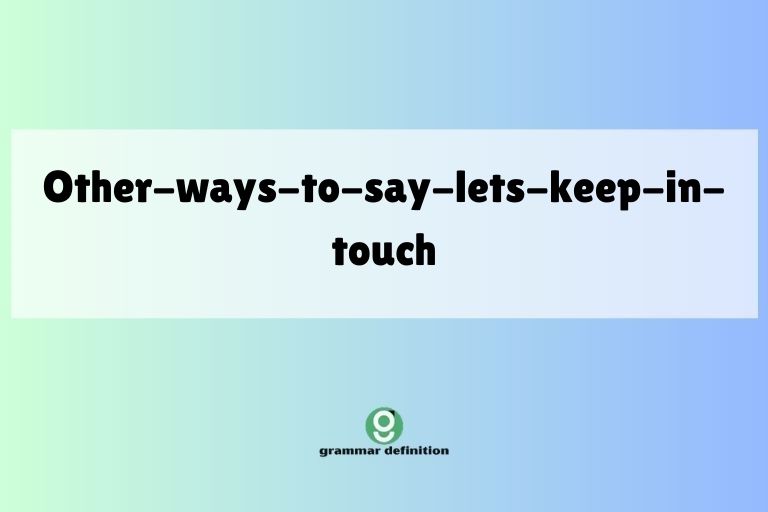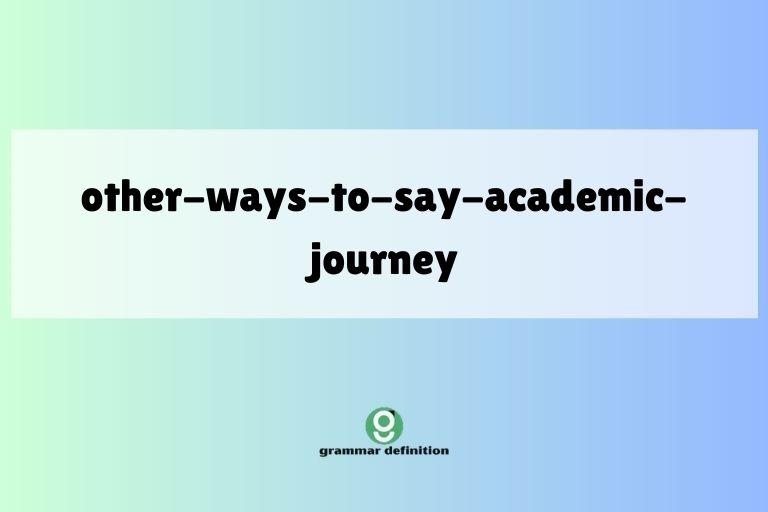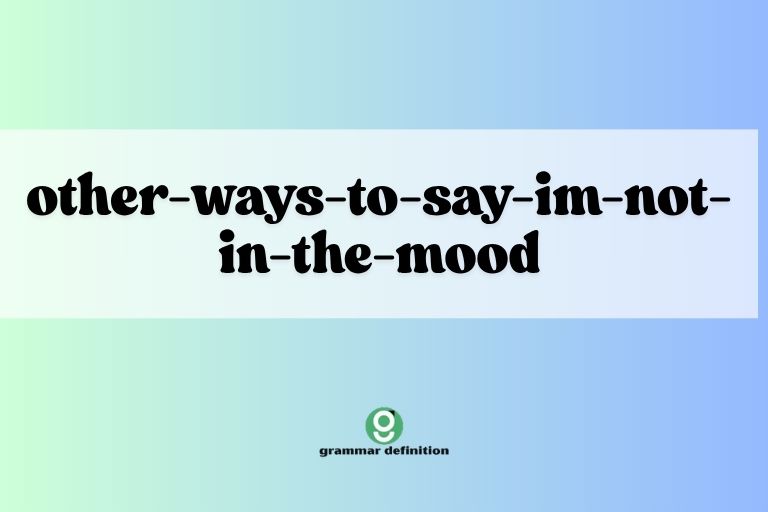Beyond “Best Regards”: Mastering Alternative Closing Phrases
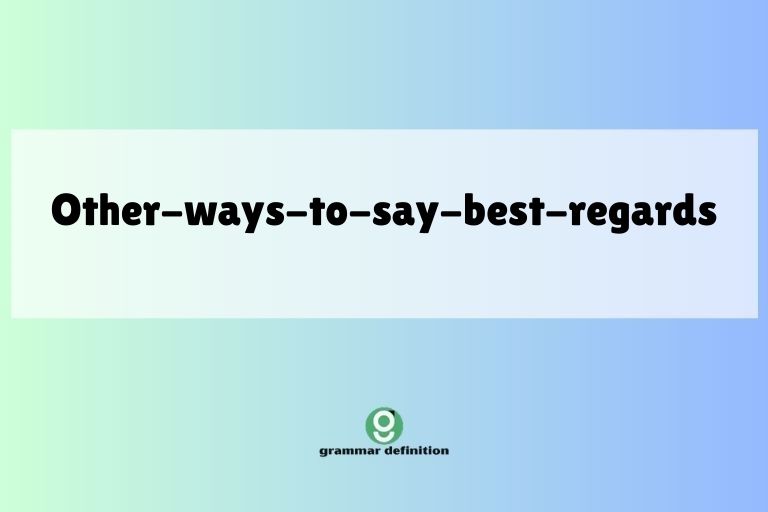
Choosing the right closing for an email or letter is crucial for leaving a positive and professional impression. While “Best regards” is a common and generally safe option, it can sometimes feel generic or lack the specific tone you want to convey.
Understanding alternative closing phrases allows you to tailor your communication to the recipient, the context, and your desired level of formality. This article provides a comprehensive guide to various ways to say “Best regards,” exploring their meanings, usage, and appropriateness in different situations.
Whether you’re writing to a close colleague, a potential employer, or a valued client, mastering these alternatives will enhance your communication skills and make your writing more impactful.
This guide is beneficial for anyone looking to improve their professional communication, including students, job seekers, business professionals, and anyone who wants to add variety and nuance to their written correspondence. By understanding the subtle differences between these phrases, you can ensure your message is well-received and reflects your intended tone.
Table of Contents
- Introduction
- Definition of “Best Regards” and Its Purpose
- Structural Breakdown of Closing Phrases
- Types and Categories of Closing Phrases
- Examples of Alternative Closing Phrases
- Usage Rules for Closing Phrases
- Common Mistakes to Avoid
- Practice Exercises
- Advanced Topics: Nuances and Cultural Considerations
- Frequently Asked Questions
- Conclusion
Definition of “Best Regards” and Its Purpose
“Best regards” is a polite and generally formal closing used in letters, emails, and other forms of written communication. Its purpose is to express goodwill and respect to the recipient.
It signals the end of the message while leaving a positive final impression. The phrase implies that you are sending your best wishes to the person you are addressing.
It’s a versatile option suitable for many business or professional contexts, but it’s not always the most appropriate choice.
The level of formality in “Best regards” sits somewhere between very formal closings like “Sincerely” or “Respectfully” and more casual options such as “Cheers” or “Thanks.” It’s a safe bet when you’re unsure of the recipient’s preferences or the appropriate tone for the situation. However, choosing a more tailored closing can often strengthen your message and make it more memorable.
Structural Breakdown of Closing Phrases
Closing phrases typically consist of one to three words and are followed by a comma. The first word is often capitalized, while the subsequent words are not, unless they are proper nouns.
The closing phrase is placed on a separate line from the body of the message and is followed by your name on the next line. It is good practice to leave a blank line between the last paragraph of your message and the closing phrase for visual clarity.
The basic structure is as follows:
[Body of the message]
[Blank Line]
[Closing Phrase],
[Your Name]
For example:
Thank you for your time and consideration. I look forward to hearing from you soon.
Best regards,
John Smith
Types and Categories of Closing Phrases
Closing phrases can be categorized based on their level of formality and the specific context in which they are appropriate. Here’s a breakdown of common categories:
Formal Closings
Formal closings are suitable for official correspondence, such as letters to government officials, formal business proposals, or when addressing someone you don’t know well. They convey a high level of respect and professionalism.
Semi-Formal Closings
Semi-formal closings are appropriate for most business communications, especially when you have an established relationship with the recipient. They strike a balance between professionalism and friendliness.
Informal Closings
Informal closings are best reserved for personal communication with friends, family, or close colleagues where a relaxed and friendly tone is appropriate. They are generally not suitable for formal business contexts.
Business Professional Closings
These closings are tailored for specific business situations, such as expressing gratitude, anticipation, or willingness to assist. They are slightly more specific than general formal or semi-formal options.
Warm and Personal Closings
These closings add a touch of warmth and sincerity to your message. They are suitable for situations where you want to express genuine appreciation or build a stronger connection with the recipient.
While not always appropriate in the most formal settings, they can be effective in building rapport.
Examples of Alternative Closing Phrases
Here are several examples of alternative closing phrases, categorized by their level of formality. Each section includes a table with numerous examples to help you choose the right phrase for any situation.
Formal Examples
These closing phrases are best suited for situations requiring the utmost respect and formality. They are often used in official correspondence or when addressing someone of high authority.
The following table provides a list of formal email closings:
| Closing Phrase | Example Sentence |
|---|---|
| Sincerely, | Sincerely, [Your Name] |
| Respectfully, | Respectfully, [Your Name] |
| Yours truly, | Yours truly, [Your Name] |
| Very truly yours, | Very truly yours, [Your Name] |
| Cordially, | Cordially, [Your Name] |
| Faithfully, | Faithfully, [Your Name] (used when addressing someone with a specific title or position) |
| Yours faithfully, | Yours faithfully, [Your Name] (used when the recipient’s name is unknown) |
| With great respect, | With great respect, [Your Name] |
| I remain, | I remain, [Your Name] (archaic but still used in very formal contexts) |
| With profound respect, | With profound respect, [Your Name] |
| In anticipation of your response, | In anticipation of your response, [Your Name] |
| Thank you for your attention to this matter, | Thank you for your attention to this matter, [Your Name] |
| Humbly yours, | Humbly yours, [Your Name] |
| Awaiting your kind response, | Awaiting your kind response, [Your Name] |
| With utmost sincerity, | With utmost sincerity, [Your Name] |
| I have the honor to remain, | I have the honor to remain, [Your Name] |
| I am, with great respect, | I am, with great respect, [Your Name] |
| With due respect, | With due respect, [Your Name] |
| Thanking you in advance, | Thanking you in advance, [Your Name] |
| I look forward to your reply with great interest, | I look forward to your reply with great interest, [Your Name] |
| With the highest regards, | With the highest regards, [Your Name] |
| I remain at your service, | I remain at your service, [Your Name] |
| Awaiting your favorable reply, | Awaiting your favorable reply, [Your Name] |
Semi-formal Examples
These closings are appropriate for most business communications. They offer a balance between professionalism and a friendly tone.
They demonstrate respect while maintaining a comfortable level of engagement.
The table below presents a collection of semi-formal email closings:
| Closing Phrase | Example Sentence |
|---|---|
| Best, | Best, [Your Name] |
| Regards, | Regards, [Your Name] |
| Kind regards, | Kind regards, [Your Name] |
| Warm regards, | Warm regards, [Your Name] |
| Best wishes, | Best wishes, [Your Name] |
| Sincerely yours, | Sincerely yours, [Your Name] |
| Respectfully yours, | Respectfully yours, [Your Name] |
| All the best, | All the best, [Your Name] |
| Have a great day, | Have a great day, [Your Name] |
| Have a good day, | Have a good day, [Your Name] |
| Looking forward, | Looking forward, [Your Name] |
| With appreciation, | With appreciation, [Your Name] |
| Thank you, | Thank you, [Your Name] |
| Many thanks, | Many thanks, [Your Name] |
| Gratefully, | Gratefully, [Your Name] |
| Yours, | Yours, [Your Name] (less common but still acceptable) |
| Happy to help, | Happy to help, [Your Name] |
| At your service, | At your service, [Your Name] |
| I appreciate your time, | I appreciate your time, [Your Name] |
| With gratitude, | With gratitude, [Your Name] |
| I hope this helps, | I hope this helps, [Your Name] |
| Looking forward to connecting, | Looking forward to connecting, [Your Name] |
| Eagerly awaiting your response, | Eagerly awaiting your response, [Your Name] |
Informal Examples
These closings are appropriate for personal communication with friends, family, or close colleagues. They convey a relaxed and friendly tone.
Avoid using these in formal business settings.
The subsequent table showcases a variety of informal email closings:
| Closing Phrase | Example Sentence |
|---|---|
| Cheers, | Cheers, [Your Name] |
| Thanks, | Thanks, [Your Name] |
| Take care, | Take care, [Your Name] |
| Best wishes, | Best wishes, [Your Name] |
| Talk soon, | Talk soon, [Your Name] |
| See you soon, | See you soon, [Your Name] |
| Later, | Later, [Your Name] |
| Bye, | Bye, [Your Name] |
| All the best, | All the best, [Your Name] |
| Warmly, | Warmly, [Your Name] |
| Love, | Love, [Your Name] (for close friends and family) |
| Thinking of you, | Thinking of you, [Your Name] |
| Hugs, | Hugs, [Your Name] (for close friends and family) |
| Yours, | Yours, [Your Name] |
| Best, | Best, [Your Name] |
| See ya, | See ya, [Your Name] |
| Catch you later, | Catch you later, [Your Name] |
| Regards, | Regards, [Your Name] |
| Have a good one, | Have a good one, [Your Name] |
| Take it easy, | Take it easy, [Your Name] |
| Peace, | Peace, [Your Name] |
| Good talking to you, | Good talking to you, [Your Name] |
| Hope to hear from you soon, | Hope to hear from you soon, [Your Name] |
Business Professional Examples
These closings are tailored for specific business situations, such as expressing gratitude or anticipation. They are slightly more specific than general formal or semi-formal options.
These examples show you how to end a message for a specific purpose.
The table below presents a collection of business-professional email closings:
| Closing Phrase | Example Sentence |
|---|---|
| Thank you for your consideration, | Thank you for your consideration, [Your Name] |
| Thank you for your time, | Thank you for your time, [Your Name] |
| Looking forward to your reply, | Looking forward to your reply, [Your Name] |
| Looking forward to hearing from you, | Looking forward to hearing from you, [Your Name] |
| Awaiting your response, | Awaiting your response, [Your Name] |
| I look forward to discussing this further, | I look forward to discussing this further, [Your Name] |
| Please let me know if you have any questions, | Please let me know if you have any questions, [Your Name] |
| Feel free to contact me with any questions, | Feel free to contact me with any questions, [Your Name] |
| Hoping to hear from you soon, | Hoping to hear from you soon, [Your Name] |
| I appreciate your prompt attention to this matter, | I appreciate your prompt attention to this matter, [Your Name] |
| Thank you for your assistance, | Thank you for your assistance, [Your Name] |
| Your attention to this is greatly appreciated, | Your attention to this is greatly appreciated, [Your Name] |
| I am available at your convenience, | I am available at your convenience, [Your Name] |
| Thank you for your business, | Thank you for your business, [Your Name] |
| We appreciate your business, | We appreciate your business, [Your Name] |
| I value your partnership, | I value your partnership, [Your Name] |
| I’m here to help, | I’m here to help, [Your Name] |
| Please do not hesitate to reach out, | Please do not hesitate to reach out, [Your Name] |
| I remain at your disposal, | I remain at your disposal, [Your Name] |
| I am at your service, | I am at your service, [Your Name] |
| We look forward to serving you, | We look forward to serving you, [Your Name] |
| With sincere appreciation, | With sincere appreciation, [Your Name] |
| I anticipate a favorable response, | I anticipate a favorable response, [Your Name] |
| Thank you for your cooperation, | Thank you for your cooperation, [Your Name] |
Warm and Personal Examples
These closings add a touch of warmth and sincerity to your message. They are suitable for situations where you want to express genuine appreciation or build a stronger connection with the recipient.
These closings are more personal than formal closings but less intimate than informal closings used for close friends and family.
The following table provides a list of warm and personal email closings:
| Closing Phrase | Example Sentence |
|---|---|
| Warmly, | Warmly, [Your Name] |
| With gratitude, | With gratitude, [Your Name] |
| With sincere thanks, | With sincere thanks, [Your Name] |
| With appreciation, | With appreciation, [Your Name] |
| Thinking of you, | Thinking of you, [Your Name] |
| With kindest regards, | With kindest regards, [Your Name] |
| Wishing you well, | Wishing you well, [Your Name] |
| Hope this helps, | Hope this helps, [Your Name] |
| With heartfelt thanks, | With heartfelt thanks, [Your Name] |
| Gratefully yours, | Gratefully yours, [Your Name] |
| Kind wishes, | Kind wishes, [Your Name] |
| With warmest wishes, | With warmest wishes, [Your Name] |
| I value your friendship, | I value your friendship, [Your Name] |
| With heartfelt gratitude, | With heartfelt gratitude, [Your Name] |
| With sincere appreciation, | With sincere appreciation, [Your Name] |
| I am truly grateful, | I am truly grateful, [Your Name] |
| With genuine appreciation, | With genuine appreciation, [Your Name] |
| I am deeply thankful, | I am deeply thankful, [Your Name] |
| With sincere thanks and appreciation, | With sincere thanks and appreciation, [Your Name] |
| I sincerely appreciate your help, | I sincerely appreciate your help, [Your Name] |
| With a grateful heart, | With a grateful heart, [Your Name] |
| I am forever grateful, | I am forever grateful, [Your Name] |
| With heartfelt sincerity, | With heartfelt sincerity, [Your Name] |
Usage Rules for Closing Phrases
Choosing the appropriate closing phrase is crucial for maintaining a consistent and professional tone. Here are some general rules to follow:
- Consider your relationship with the recipient: The closer your relationship, the more informal you can be.
- Reflect the tone of your message: If your message is serious or formal, choose a formal closing. If it’s friendly and casual, opt for an informal one.
- Know your audience: Be aware of cultural differences and sensitivities when choosing a closing phrase.
- Maintain consistency: Use a closing phrase that aligns with the rest of your communication.
- Always use a comma: Follow the closing phrase with a comma.
Common Mistakes to Avoid
Using the wrong closing phrase can create a negative impression. Here are some common mistakes to avoid:
- Using informal closings in formal situations: Avoid using phrases like “Cheers” or “Bye” in professional emails.
- Using overly formal closings with close colleagues: Phrases like “Respectfully” can sound stiff or insincere with people you know well.
- Misspelling closing phrases: Always double-check your spelling to avoid looking unprofessional.
- Forgetting the comma: Always include a comma after the closing phrase.
- Using a closing that doesn’t match the tone of your message: Ensure the closing aligns with the overall tone and content of your email.
Here’s a table illustrating some common mistakes and their corrections:
| Incorrect | Correct | Explanation |
|---|---|---|
| Cheers John | Cheers, John | Missing comma after the closing phrase. |
| Respectfully, Mark |
Respectfully, Mark |
The signature should be on a separate line. |
| Best Regards. | Best regards, | Incorrect capitalization and punctuation. |
| Warmly, Mr. Smith | Warmly, John Smith | Using a first name is more appropriate with a warm closing. |
| Bye, Sir | Respectfully, Sir | “Bye” is too informal for addressing someone as “Sir”. |
| Thankyou, | Thank you, | Incorrect spelling. |
| Sincerly, | Sincerely, | Incorrect spelling. |
| Best Wishes. | Best wishes, | Incorrect punctuation. |
| All the best! | All the best, | Incorrect punctuation. |
| Regards\nJohn Doe | Regards, John Doe |
Incorrect line break. |
Practice Exercises
Test your understanding with these practice exercises. Choose the most appropriate closing phrase for each scenario.
Exercise 1: Choose the best closing phrase for the following scenarios.
| Scenario | Possible Closing Phrases | Your Answer |
|---|---|---|
| 1. Email to a potential employer after an interview. | a) Cheers, b) Sincerely, c) Take care | |
| 2. Email to a close colleague about a casual project update. | a) Regards, b) Later, c) Respectfully | |
| 3. Letter to a government official expressing your concerns. | a) Yours truly, b) Bye, c) Best | |
| 4. Email to a client thanking them for their business. | a) Warmly, b) Thank you for your business, c) See ya | |
| 5. Email to a friend inviting them to a party. | a) Sincerely, b) Take care, c) Love | |
| 6. A formal complaint letter to a company. | a) Best, b) Respectfully, c) Bye | |
| 7. Email to your professor regarding an assignment. | a) Cheers, b) Sincerely, c) Take it easy | |
| 8. A thank-you note to a family member for a gift. | a) Regards, b) With gratitude, c) Later | |
| 9. A follow-up email to a networking contact. | a) Respectfully, b) Looking forward to connecting, c) Peace | |
| 10. A resignation letter to your manager. | a) Take care, b) Sincerely, c) Bye |
Answer Key:
| Question | Answer |
|---|---|
| 1 | b) Sincerely, |
| 2 | a) Regards, |
| 3 | a) Yours truly, |
| 4 | b) Thank you for your business, |
| 5 | c) Love, |
| 6 | b) Respectfully, |
| 7 | b) Sincerely, |
| 8 | b) With gratitude, |
| 9 | b) Looking forward to connecting, |
| 10 | b) Sincerely, |
Exercise 2: Rewrite the following sentences with a more appropriate closing phrase.
- “Dear Mr. Johnson, I hope you are doing well. Cheers, John Smith.”
- “To my dearest friend, I’m so glad we reconnected. Respectfully, Jane Doe.”
- “Dear Sir/Madam, I am writing to complain about your service. Later, David Lee.”
- “Hi Sarah, Thanks for the update. Sincerely, Tom Brown.”
- “Dear Professor, I hope you have a great day! Bye, Emily White.”
- “Dear Manager, I am submitting my expenses. Warmly, Alex Green.”
- “Dear Customer, We appreciate your feedback. Love, Company X.”
- “Hi Mom, I’ll see you soon. Sincerely, Your Son.”
- “Dear Recruiter, I am looking forward to the interview. Peace, Applicant.”
- “Dear Colleague, Here are the project files. Respectfully, Team Lead.”
Answer Key:
- “Dear Mr. Johnson, I hope you are doing well. Sincerely, John Smith.”
- “To my dearest friend, I’m so glad we reconnected. Warmly, Jane Doe.”
- “Dear Sir/Madam, I am writing to complain about your service. Yours faithfully, David Lee.”
- “Hi Sarah, Thanks for the update. Regards, Tom Brown.”
- “Dear Professor, I hope you have a great day! Sincerely, Emily White.”
- “Dear Manager, I am submitting my expenses. Regards, Alex Green.”
- “Dear Customer, We appreciate your feedback. Thank you, Company X.”
- “Hi Mom, I’ll see you soon. Love, Your Son.”
- “Dear Recruiter, I am looking forward to the interview. Best regards, Applicant.”
- “Dear Colleague, Here are the project files. Regards, Team Lead.”
Advanced Topics: Nuances and Cultural Considerations
Beyond the basic rules, mastering the art of closing phrases involves understanding subtle nuances and cultural considerations. In some cultures, certain closings may be considered too forward or informal, while others may be seen as cold or impersonal.
For instance, in some Asian cultures, expressing humility and respect is highly valued, so a more formal closing might be preferred even in casual business communications.
Furthermore, the use of “Ms.” or “Mr.” can also influence the choice of closing. When addressing someone with a formal title, a more formal closing like “Sincerely” or “Respectfully” is generally more appropriate.
Conversely, if you’re on a first-name basis with the recipient, a semi-formal or even informal closing might be suitable.
Pay attention to the communication style of the recipient. If they consistently use formal closings, mirroring their style will demonstrate respect and professionalism.
If they tend to use more casual closings, you can gradually adopt a similar style, but always err on the side of caution, especially in initial communications.
Frequently Asked Questions
- Q: Is “Best regards” always appropriate?
A: While generally safe, “Best regards” can sometimes feel generic. Consider the context and your relationship with the recipient to choose a more tailored closing.
- Q: When should I use “Sincerely” instead of “Best regards”?
A: “Sincerely” is more formal than “Best regards” and is appropriate for official correspondence or when addressing someone you don’t know well. It conveys a high level of respect and professionalism.
- Q: Can I use “Cheers” in a business email?
A: “Cheers” is generally too informal for most business emails. It’s best reserved for personal communication with friends or close colleagues.
- Q: What if I don’t know the recipient’s name?
A: If you don’t know the recipient’s name, use “Yours faithfully,” which is a formal closing typically used in such situations. If you know their title, you can use “Faithfully,”
- Q: Is it okay to use no closing phrase at all?
A: While not strictly incorrect, omitting a closing phrase can come across as abrupt or impersonal. It’s generally best to include a closing phrase to show politeness and respect.
- Q: How important is the comma after the closing phrase?
A: The comma is essential for proper grammar and punctuation. Omitting it can make your writing look careless or unprofessional. Always include a comma after the closing phrase.
- Q: Can I use emojis in my closing phrase?
A: Emojis are generally not appropriate in professional communication, especially in formal contexts. Avoid using them in your closing phrase.
- Q: How do I choose a closing phrase that reflects my personality?
A: While it’s important to be professional, you can choose a closing phrase that aligns with your communication style. For example, if you’re generally warm and friendly, “Warm regards” might be a good option. However, always prioritize appropriateness and professionalism.
Conclusion
Mastering alternative closing phrases is an essential skill for effective communication. By understanding the nuances of different closings and their appropriate contexts, you can tailor your messages to create a positive and lasting impression.
While “Best regards” is a versatile option, exploring other alternatives allows you to add personality, warmth, and professionalism to your writing. Remember to consider your relationship with the recipient, the tone of your message, and any cultural considerations when making your choice.
Practice using these phrases in different scenarios to become more comfortable and confident in your communication skills.
By incorporating a variety of closing phrases into your repertoire, you’ll be able to communicate more effectively and leave a positive impression on your readers. With careful consideration and practice, you can master the art of choosing the perfect closing phrase for any situation, enhancing your communication skills and building stronger relationships.

